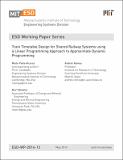| dc.contributor.author | Pena-Alcaraz, Maite | |
| dc.contributor.author | Webster, Mort | |
| dc.contributor.author | Ramos, Andres | |
| dc.date.accessioned | 2016-06-06T20:42:10Z | |
| dc.date.available | 2016-06-06T20:42:10Z | |
| dc.date.issued | 2014-05 | |
| dc.identifier.uri | http://hdl.handle.net/1721.1/103005 | |
| dc.description.abstract | In the last 15 years, the use of rail infrastructure by different train operating companies (shared railway system) has been proposed as a way to improve infrastructure utilization and to increase efficiency in the railway industry. Shared use requires coordination between the infrastructure manager and multiple train operators in a competitive framework, so that regulators must design appropriate capacity pricing and allocation mechanisms. However, the resulting capacity utilization from a given mechanism in the railway industry cannot be known in the absence of operations. Therefore assessment of capacity requires the determination of the train timetable, which eliminates any potential conflicts in bids from the operators. Although there is a broad literature that proposes train timetabling methods for railway systems with single operators, there are few models for shared competitive railway systems. This paper proposes a train timetabling model for shared railway systems that explicitly considers network effects and the existence of multiple operators requesting to operate several types of trains traveling along different routes in the network. The model is formulated and solved both as a mixed integer linear programming (MILP) problem (using a commercial solver) and as a dynamic programming (DP) problem. We solve the DP formulation with a novel algorithm based on a linear programming (LP) approach to approximate dynamic programming (ADP) that can solve much larger problems than are computationally intractable with commercial MILP solvers. The model simulates the optimal decisions by an infrastructure manager for a shared railway system with respect to a given objective function and safety constraints. This model can be used to evaluate alternative capacity pricing and allocation mechanism. We demonstrate the method for one possible capacity pricing and allocation mechanism, and show how the competing demands and the decisions of the infrastructure manager under this mechanism impact the operations on a shared railway system for all stakeholders. | en_US |
| dc.language.iso | en_US | en_US |
| dc.publisher | Massachusetts Institute of Technology. Engineering Systems Division | en_US |
| dc.relation.ispartofseries | ESD Working Papers;ESD-WP-2014-13 | |
| dc.title | Train Timetable Design for Shared Railway Systems using a Linear Programming Approach to Approximate Dynamic Programming | en_US |
| dc.type | Working Paper | en_US |
